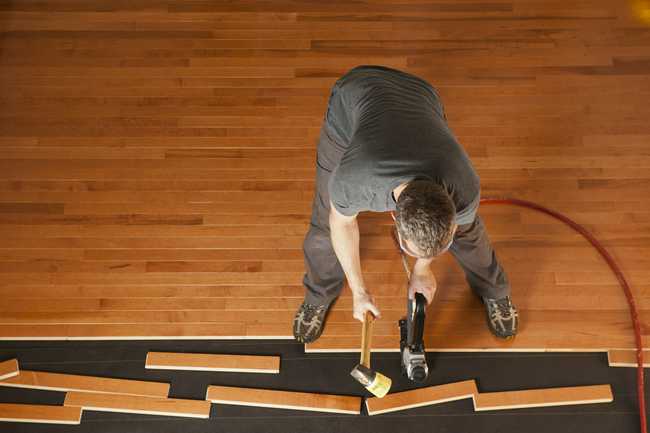When it comes to selecting the right flooring for your home, the choices can be overwhelming. Among the various options available, tongue and groove flooring stands out as a popular and reliable choice for both practical and aesthetic reasons. In this comprehensive guide, we’ll explore tongue and groove flooring, its advantages and disadvantages, and whether it’s a good fit for your next flooring project.
Understanding Tongue and Groove Flooring
Tongue and groove flooring is a type of hardwood or engineered wood flooring where each plank has a protruding “tongue” that fits into a groove on the adjoining plank. This design creates a tight and seamless connection between the planks, enhancing stability and reducing movement over time. This method results in a strong, interlocking bond that helps prevent gaps between the boards.
Advantages of Tongue and Groove Flooring
1. Stability: One of the primary benefits of tongue and groove flooring is its stability. The interlocking design ensures the planks stay firmly in place, minimizing shifting or buckling.
2. Durability: Tongue and groove flooring is known for its durability. The tight fit between planks helps protect against moisture and reduces the risk of damage from heavy foot traffic.
3. Easy Installation: While professional installation is recommended for optimal results, confident DIYers can install tongue and groove flooring. The interlocking system simplifies the installation process, saving time and effort.
4. Seamless Appearance: Once installed, tongue and groove flooring creates a smooth and seamless surface without visible gaps, enhancing the overall appearance of the room.
5. Variety of Options: Tongue and groove flooring is available in a wide range of wood species, finishes, and styles, making it adaptable to various interior design preferences.
6. Compatible with Underfloor Heating: This type of flooring is compatible with underfloor heating systems, providing comfort and warmth during colder months.
Disadvantages of Tongue and Groove Flooring
1. Moisture Sensitivity: While the interlocking design helps resist moisture, excessive exposure to water can still cause damage over time, particularly in humid environments or areas prone to spills.
2. Potential for Noise: In some cases, tongue and groove flooring can produce creaking or squeaking sounds, especially if not installed correctly or if the subfloor is uneven.
3. Cost: Tongue and groove flooring, especially solid hardwood options, can be more expensive than other types of flooring materials.
Is Tongue and Groove Flooring Right for You?
Whether tongue and groove flooring is suitable for your home depends on several factors:
· Location: Consider the room where you plan to install the flooring. Tongue and groove flooring is ideal for living areas, bedrooms, and even kitchens but may not be the best choice for basements or bathrooms due to potential moisture issues.
· Budget: Evaluate your budget and compare the cost of tongue and groove flooring with other flooring options. While it may be a higher initial investment, the durability and aesthetic appeal can make it a worthwhile long-term investment.
· Climate: If you live in a climate with high humidity levels, taking extra precautions to protect tongue and groove flooring from moisture is essential.
· Installation: Assess whether you have the skills and tools required for installation or would prefer to hire a professional.
Maintenance Tips for Tongue and Groove Flooring
Once installed, proper maintenance is crucial to preserve the beauty and longevity of tongue and groove flooring:
· Regular Cleaning: Sweep or vacuum regularly to remove dirt and debris that can scratch the surface. Use a damp mop with a mild hardwood floor cleaner for deeper cleaning.
· Avoid Excess Moisture: Wipe up spills promptly to prevent water damage. Use rugs or mats in high-traffic areas and near entryways to protect against moisture and dirt.
· Routine Inspections: Periodically check for signs of wear, such as scratches or gaps between the planks. Address any issues promptly to prevent further damage.
· Refinishing: Depending on the wear and tear, consider refinishing the flooring every few years to restore its original luster and protect the surface.
Enhancing Your Home with Tongue and Groove Flooring
Tongue and groove flooring can significantly enhance your home’s aesthetic appeal and value. Here are some creative ways to incorporate this versatile flooring option:
· Create Visual Interest: Experiment with different wood species or finishes to complement your interior design style. Consider mixing plank widths or creating intricate patterns like herringbone for a unique look.
· Open Floor Plans: Tongue and groove flooring is an excellent choice for open floor plans, providing a cohesive and continuous look throughout the space.
· Customization: Explore custom finishes or distressing techniques to achieve a personalized and distinctive appearance.
· Sustainability: Choose sustainably sourced wood for your tongue and groove flooring to minimize environmental impact.
Final Thoughts
Tongue and groove flooring offers a blend of timeless elegance and practical functionality, making it a favored choice for homeowners seeking durability and style. Before making a decision, consider your specific needs, lifestyle, and budget to determine if tongue and groove flooring is the right fit for your home. With proper care and maintenance, this type of flooring can provide years of beauty and value to your living space. Whether you’re renovating an existing home or planning a new construction, tongue and groove flooring can be an excellent investment that enhances the overall comfort and aesthetic appeal of your living environment.
Don’t miss out on updates and alerts – stay connected! Gossips




